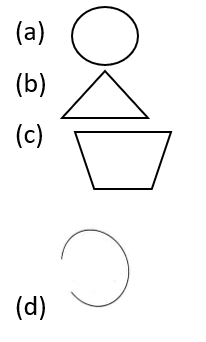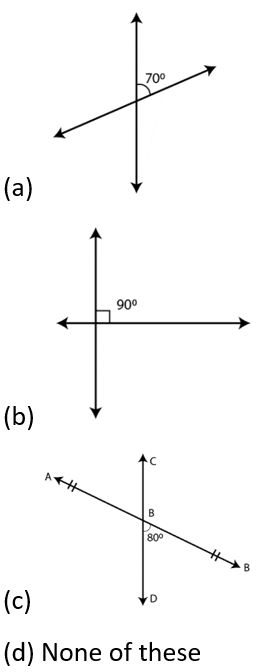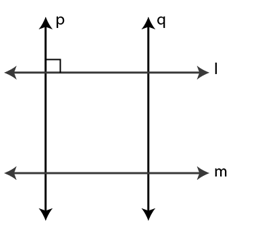ICSE 6 Maths
Fundamental Concepts - Geometry


Question 1:
Which of the following statement is not true? [Level: Easy]
(a) Three points are said to be collinear, if they lie in the same plane.
(b) A ray has an infinite length only on one side of it.
(c) A dot has width only.
(d) Line segment is a part of line.
Question 2:
Infinite number of lines drawn from a __________.
(a) Line
(b) ray
(c) point
(d) line segment
Question 3:
Which of the following is an example of parallel lines? [Level: Easy]
(a)
(b)
(c)
(d)
Question 4:
Intersection of two different lines in a plane only intersect at __________. [Level: Easy]
(a) only at one point
(b) two points
(c) three points
(d) infinite point
Question 5:
With the help of figure, how many pairs of parallel lines in there? [Level: Moderate]
(a) 3 pairs of parallel lines
(b) 2 pairs of parallel lines
(c) only one pair of parallel lines
(d) no pair of parallel lines
Question 6:
Which of the following statement is true? [Level: Moderate]
(a) A ray has a definite length.
(b) A line has a countable number of points in it.
(c) Only one line can pass through a given point.
(d) The intersection of two planes is a straight line.
Question 7:
Which of the following is an example of open curve? [Level: Moderate]

Question 8:
If a closed figure is not bounded by line segments only, the figure is said to be __________. [Level: Moderate]
(a) curvilinear boundaries
(b) linear boundaries
(c) both
(d) none of these
Question 9:
Every line segment has a __________ perpendicular bisector of it. [Level: Moderate]
(a) unique
(b) two
(c) three
(d) none of these
Question 10:
Which of the following statement is not true? [Level: Difficult]
(a) The maximum number of lines passing through three collinear points is one only.
(b) There is no number of lines passing through three non- collinear points.
(c) Concurrent lines always meet at the same point.
(d) Two parallel lines never lie in the same plane.
Question 11:
Which of the following is an example of curved surfaces? [Level: Moderate]
(a) the surface of an apple
(b) edges of textbook
(c) tip of a compass
(d) the surface of a book
Question 12:
In a classroom, some of the figures are drawn on board in which of the following is four-sided plane closed figure? [Level: Moderate]
(a) triangle
(b) circle
(c) square
(d) rectangle
Question 13:
In a quiz one of the questions in which students gets confused, A rectangle has opposite sides __________ to each other, Can you help them to identify the option? [Level: Difficult]
(a) equal and perpendicular
(b) perpendicular and unequal
(c) parallel and unequal
(d) equal and parallel
Question 14:
Sakshi asked from Aman then in a rectangle there are four side and can you tell me that in a rectangle has adjacent sides __________ to each other. [Level: Moderate]
(a) unequal and perpendicular
(b) equal and perpendicular
(c) unequal and parallel
(d) equal and parallel
Question 15:
Kids are playing with carroms, suddenly one of the asked that to identify the shape of carrom and then asked if the sides of a square are __________to each other and each angle is__________. [Level: Difficult]
(a) Square, unequal and 90o
(b) Square, equal and 90o
(c) Rectangle, equal and 45o
(d) Rectangle, unequal and 45o
Question 16:
At what angle two lines are perpendicular to each other? [Level: Moderate]
(a) 45o
(b) 0o
(c) 30o
(d) 90o
Question 17:
If three or more straight lines (in the same plane) pass through the same point, the lines are called __________ and that point is called __________. [Level: Moderate]
(a) concurrent lines and the point of concurrence
(b) intersecting lines and the point of intersection
(c) concurrent lines and point of intersection
(d) intersecting lines and point of concurrence
Question 18:
Which of the following figures shows two mutually perpendicular? [Level: Difficult]

Question 19:
In final examination, question asked that from the given figure, which of the following is the pairs of mutually perpendicular lines? [Level: Difficult]

(a) p and l, p and m, q and l, q and m
(b) p and l, p and m, q and l
(c) p and q, l and m
(d) p and l
Question 20:
How many lines can be drawn through three collinear points? [Level: Moderate]
(a) only one line
(b) no line
(c) two lines
(d) three lines
**********
In summary, problem-solving after learning a theoretical concept on CBSE Fundamental Concepts - Geometry ICSE 6 Maths is an essential part of the learning process. It enhances your understanding, critical thinking abilities, and retention of knowledge. Moreover, it equips you with valuable skills that are applicable in academic, personal, and professional contexts.
You must have heard of the phrase “Practice makes a man perfect”. Well, not just a man, practice indeed enhances perfection of every individual.
Practicing questions plays a pivotal role in achieving excellence in exams. Just as the adage goes, "Practice makes perfect," dedicating time to solve a diverse range of exam-related questions yields manifold benefits. Firstly, practicing questions allows students to familiarize themselves with the exam format and types of problems they might encounter. This familiarity instills confidence, reducing anxiety and improving performance on the actual exam day. Secondly, continuous practice sharpens problem-solving skills and enhances critical thinking, enabling students to approach complex problems with clarity and efficiency. Thirdly, it aids in identifying weak areas, allowing students to focus their efforts on improving specific topics. Moreover, practice aids in memory retention, as active engagement with the material reinforces learning. Regular practice also hones time management skills, ensuring that students can allocate appropriate time to each question during the exam. Overall, practicing questions not only boosts exam performance but also instills a deeper understanding of the subject matter, fostering a holistic and effective learning experience.
All About Daily Practice Problems on ICSE 6 Maths Fundamental Concepts - Geometry NCERT Chapter 17
Our Daily Practice Problems (DPPs) offer a diverse range of question types, including Multiple Choice Questions (MCQs) as well as short and long answer types. These questions are categorized into Easy, Moderate, and Difficult levels, allowing students to gradually progress and challenge themselves accordingly. Additionally, comprehensive solutions are provided for each question, available for download in PDF format - Download pdf solutions as well as Download pdf Questions. This approach fosters a holistic learning experience, catering to different learning styles, promoting self-assessment, and improving problem-solving skills. With our well-structured DPPs, students can excel in exams while gaining a deeper understanding of the subject matter. Hope you found the content on ICSE 6 Maths Fundamental Concepts - Geometry NCERT Chapter 17 useful.
Last but not least, to get the best hold on ICSE 6 Maths Fundamental Concepts - Geometry NCERT Chapter 17, do not forget to check out: